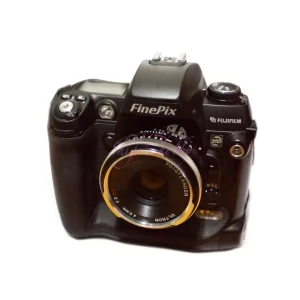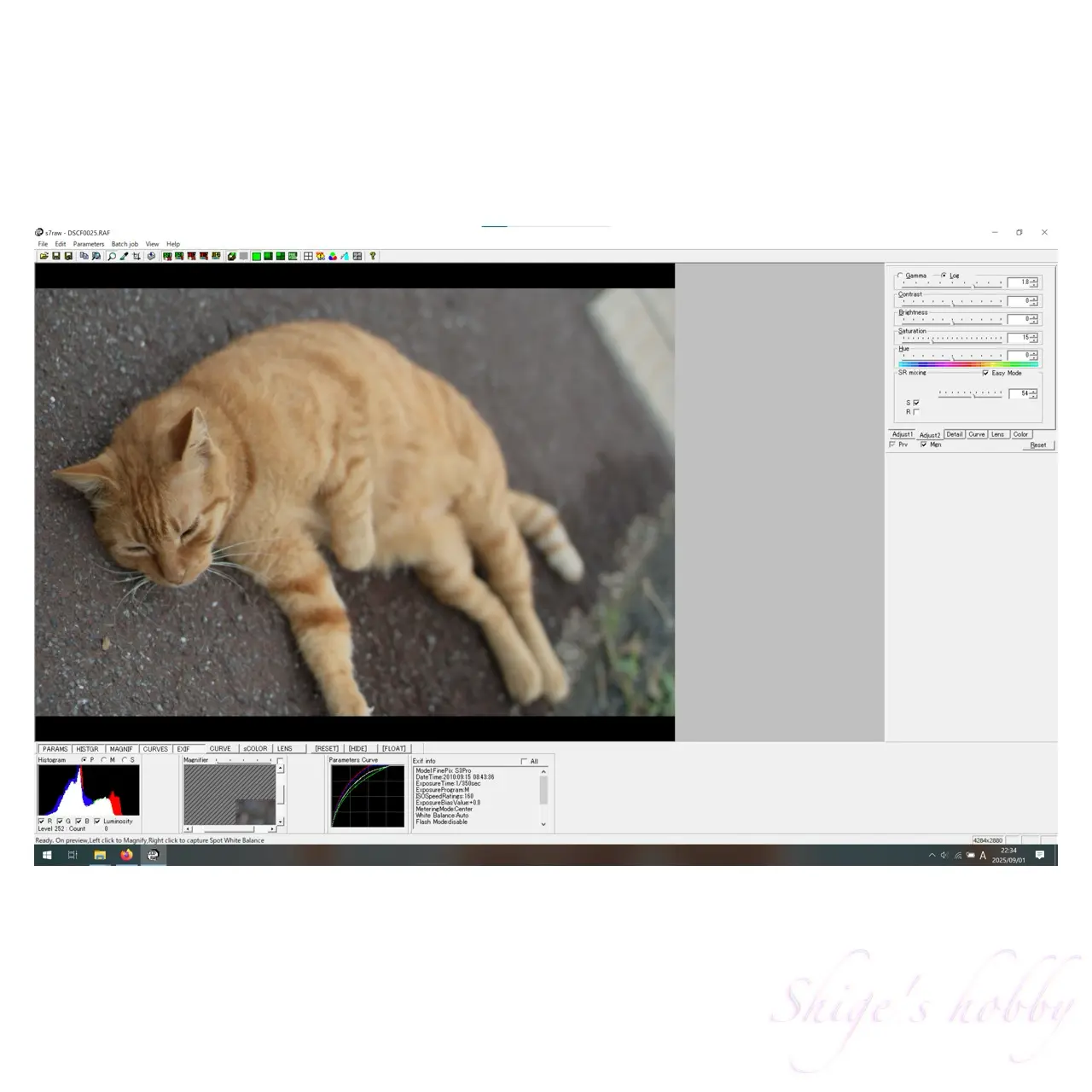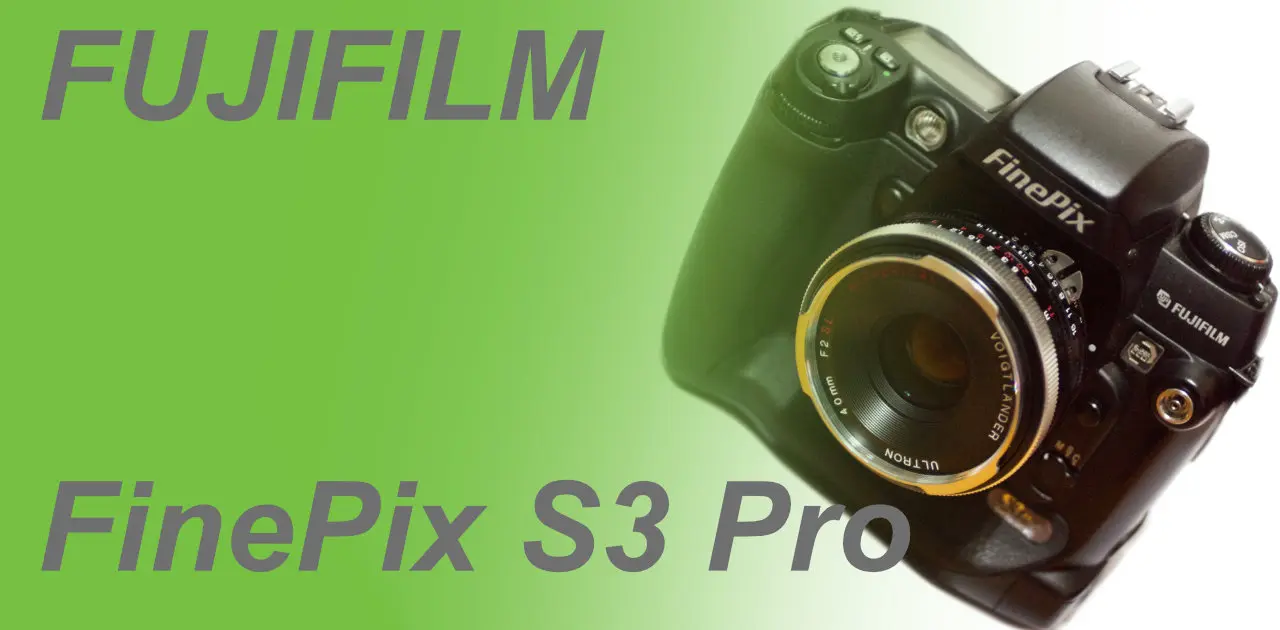- Please see the disclaimer regarding advertising here.
- Italicized links in the text are advertisement links that take you to other sites.
Table of contents
Gallery
The following cameras were used to take the sample photos:
- Voigtlander ULTRON 40mm F2
- TAMRON SP 17mm F3.5 151B
- TAMRON SP 180mm F2.5 63B
- SIGMA 50mm EX DG HSM
Review

1.Overview
The FUJIFILM FinePix S3 Pro is a digital SLR camera released in November 2004, equipped with a Super CCD Honeycomb SRII sensor.
Detailed specifications are listed in the table, but the key specifications are summarized below.
- 12.34 million effective pixels (6.17 million S pixels + 6.17 million R pixels), 12.9 million total pixels (6.45 million S pixels + 6.45 R pixels)
- APS-C size Super CCD Honeycomb SRII sensor
- Powered by four AA batteries
- Nikon F mount
- Two slots for XD Picture Card and CompactFlash
This SLR camera is already 20 years old, and its sluggish operation shows its age.
The image sensor is Fujifilm’s original Honeycomb sensor, making it a rare find alongside the Foveon sensor in a SLR camera market where most cameras use standard Bayer sensors.
Since the Honeycomb SR II has an APS-C size sensor, the focal length of the lens is 1.5 times that of the 35mm format.
2.Usability
A distinctive feature of the FUJIFILM FinePix S3 Pro’s refined images is the unique emotional feel of the colors in the recorded JPG images, a distinctive image quality that can be said to be a personality that Fujifilm has cultivated since the film era.
The data is recorded with a base pixel count of 6 megapixels on the sensor, so when images recorded at 12 megapixels are enlarged, it is clear that the sense of resolution is lost.
The camera’s raw data can also be recorded at 12, 6, or 3 megapixels. When 12 megapixels is selected, the raw data (RAF file) is 4256 x 2848 pixels and is approximately 26MB in size.
Since uncompressed data from a typical 12-megapixel sensor is around 12MB, the data volume is approximately double, with 12 megapixels of S pixel and 12 megapixels of R pixel data being stored.
However, since the camera’s sensor itself only has 6 megapixels each for the S and R pixels, the Raw data recorded in 12 megapixel mode is interpolated data, so if you want to save the raw data from the sensor, 6 megapixel mode is appropriate and sufficient.
Software that can develop S3Pro Raw data is RAW FILE CONVERTER, a FUJIFILM-specific version of the general-purpose Raw development software SILKYPIX, and is also compatible with the S3Pro camera.
RAW FILE CONVERTER EX 3.0 powered by SILKYPIX Compatibility Information
RAW FILE CONVERTER does not have a function to process S and R pixels separately, and the other raw development software I own, HASSELBLAD’s Phocus and Affinity Photo2, support S3Pro raw images.
I couldn’t find any noticeable differences in the appearance of the default development results of the three software. There may be differences when looking at the data byte by byte, but I’m not interested in pursuing such subtle differences.
One thing that concerns me is that these software programs may only process the main S pixel data.
This is because, using s7raw, a Windows-only development software, you can change the mixing ratio of S and R pixels.
Unfortunately, this software is not available for Mac, but 32-bit and 64-bit versions are available for Intel (AMD) CPUs.
While the download link on the official website is no longer available, you can download it from SOFTPEDIA. Of course, since it is old free software, use it at your own risk.
I used the downloaded software on Windows 10 and was able to process FinePix S3Pro data without any problems. It was confirmed that normal color data was recorded on the S side, and dark data on the R side. This shows that, like conventional honeycomb CCD sensors, it is resistant to blocked-up shadows, but has almost no effect on blown-out highlights.


Also, in response to the concern mentioned earlier that only S pixel data is being processed, a comparison of S pixel data and SR pixel mixed data shows a slight difference in color depth, with the SR pixel mixed data having deeper depth.


The data processed with the other three software programs seems close to data processed only with the S pixel, which leads me to believe that Raw development software that processes general-purpose Honeycomb SR data only looks at the S pixel. I have placed the straight development data from Affinity Photo 2 in the gallery, so although the image is compressed, you can see the degree of difference in color.
This camera uses four AA batteries. 400 shots can be taken with 1.2V nickel-metal hydride batteries, and if it operates at this voltage, I think it would be possible to take a reasonable number of shots with four alkaline batteries in an emergency.
Sometimes I really want to use a Honeycomb sensor SLR camera, but I hesitate because the lens mount is Nikon F, which makes it difficult to use lenses from other companies.
3.Summary
In conclusion, to sum up the FUJIFILM FinePix S3 Pro, the images produced by the large-format honeycomb SR sensor are unique, and it’s understandable why it’s still popular with some people even after 20 years. However, while the camera itself is quite old and its used price remains high and stable, there are many aspects of it that can be frustrating to use, so you need to consider whether it’s a camera that suits your style as a photographer.
Specifications, considerations, etc.
The FinePix S series of SLR cameras was released in four models based on Nikon cameras.
The first, the S1 Pro, was a digital camera based on the Nikon F60 film camera, while the S2 Pro and S3 Pro were based on the Nikon F80 film camera. The S5 Pro was based on the Nikon D200 digital camera.
For all digital cameras, the body exterior, shutter, and other mechanical mechanisms were provided by Nikon, but the circuit boards that process the camera’s images were original to Fujifilm, and the body shape was changed to accommodate the LCD display and internal circuit boards. The film-based S1 Pro, S2 Pro, and S3 Pro have larger bottom bodies to accommodate four AA batteries, as they are designed for power-hungry digital cameras.
Since the S5 was originally based on a digital camera, there are not many differences from the base camera.
Fujifilm subsequently abandoned the SLR market and instead focused on interchangeable-lens mirrorless cameras, developing the X series with APS-C sensors and the GFX series with medium-format digital sensors.
No new honeycomb sensors have been released since the S5 Pro. This is likely because the increased pixel count of Bayer sensors and improved image processing know-how have made it possible for them to reproduce Fujifilm’s colors, eliminating the cost and benefit of developing a new sensor.
However, perhaps out of pride as a film manufacturer, some cameras feature sensors in which the color filter placed in front of the sensor has been replaced with an “X-Trans color filter.” This is said to facilitate the production of Fujifilm’s signature colors in combination with image processing, but given that it is not used in the GFX, it seems likely that this is also a marketing element to differentiate the company from competitors.
While the Foveon sensor is often compared to the honeycomb sensor, the two companies use completely different concepts when designing their sensors. To put it simply, FOVEON is solely focused on color separation between dots, and aims to create images that emphasize accuracy and resolution. In contrast, Honeycomb sensors aim to create painterly images that leave a pleasant impression when viewed in the final recorded image.
Both have drawbacks that Bayer sensors do not have, and when you fault-check Honeycomb sensor images pixel by pixel on a monitor, you can find problems such as strange patterns and blurring of clear boundaries. FOVEON achieves correct partial color separation, but the overall result, including color balance, can sometimes be flawed.
Bayer sensors are not perfect either, and have drawbacks such as a tendency for color saturation and reduced resolution. Therefore, from my experience using a variety of cameras, I feel that from the perspective of a hobbyist photographer rather than someone taking academic documentary photographs, the decision should be made based on your preferences for the final image.
| Model name | S1 Pro | S2 Pro | S3 Pro | S5 Pro |
| Camera effective pixel count | 3.4 million pixels | 6.17 megapixels | 12.34 million pixels (S pixels: 6.17 million pixels, R pixels: 6.17 million pixels) | 12.34 million pixels (S pixels: 6.17 million pixels, R pixels: 6.17 million pixels) |
| Sensor type | Super CCD Honeycomb | Super CCD Honeycomb | Super CCD Honeycomb SRII | Super CCD Honeycomb SR Pro |
| Sensor size | APS-C | APS-C | APS-C | APS-C |
| Lens Mount | Nikon-F | Nikon-F | Nikon-F | Nikon-F |
| Rear LCD | 2-inch 200,000 pixels | 1.8-inch 110,000 pixels | 2-inch 235,000 pixels | 2.5-inch 230,000 pixels |
| Finder | Optical eye level type (field of view: approx. 90% vertically, approx. 93% horizontally) | Uses eye-level pentaprism with built-in diopter adjustment mechanism | Uses eye-level pentaprism (field of view: approximately 93% up and down, approximately 95% left and right), with diopter adjustment mechanism, viewfinder magnification: approximately 0.8x | Uses eye-level pentaprism (approx. 95% field of view up, down, left and right), with diopter adjustment mechanism, and viewfinder magnification of approx. 0.94x |
| Buffer memory | – | – | Gray batch 128MB Blue batch 256MB | – |
| Battery | 4 x AA batteries 1 x CR2025 button cell lithium battery 2 x CR123A lithium batteries | 4 x AA batteries 2 x 3V lithium batteries: CR123A | 4 x AA batteries | NP-150 |
| Recorded media | Compact Flash SmartMedia | Compact Flash SmartMedia | XD Picture Card Compact Flash | Card Compact Flash |
| Size | 148.5 × 125 x 79.5 | 141.5 × 131.0 × 79.5 | 147.8 × 135.3 × 80.0 | 147.0 × 113.0mm × 74.0 |
| Weight(g) (excluding lens, batteries, and recording media) | Approximately 800g | Approximately 760g | Approximately 815g | Approximately 830g |
| Release date | 1989.7.8 | 1991.6.21 | 2004.11.30 | 2007.1.31 |
| Price | ¥375,000 | ¥310,000 | Open | Open |
Reference links
- FinePix S3Pro・FUJIFILM Official page
- FinePix S5Pro・FUJIFILM Official page
- s7Raw・Official page
- s7Raw Download page for Windows・SOFTPEDIA
Affiliate links

Update history
- 2025.9.2



Be First to Comment